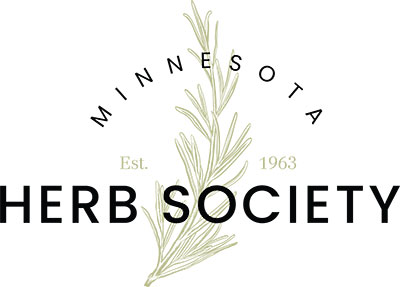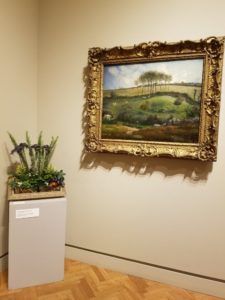The Minnesota Herb Society’s 2019 interpretation of
Pasture near Cherbourg (Normandy) Jean Franois Millet
As members of the MN Herb Society, we use herbs in our arrangement. When choosing our piece for this year’s intepretation, we felt this piece evoked a sense of peace, so we used primarily calming herbs. We also kept in mind a piece of art that would work well with the International Herb’s Society’s “Herb of the Year”. For 2019, the Herb of the Year is Anise Hyssop. While at this time of year, we could not get fresh anise hyssop, we used dried anise hyssop in our arrangement in the far right lower corner. We interpreted this artwork as having three layers to it. In the lower kind of scubby area we used thyme and rock to capture the texture of the landscape. The middle area is the pasture, and we used the green Pom mums and arranged them to depict the hills with bay as the bush on the right. We used yew to represent the fence hedge and the trees are depicted with rosemary and tricehelium. Finally the animals are represented by chamomile. Many other herbs were used. The following represent the herbs we employed. Statements about the use of these herbs are not intended to represent or imply suitability for treatment of any conditions.
Anise Hyssop – Anise hyssop has a flower similar to lavender and has many uses. In teas, it can help relieve congestion from a cold. A poultice can help treat burns and it can help relieve the itch from poison ivy. Native Americans used the leaves in an incense to treat depression as it gives off an uplifting fragrance. They also made a salve of it to treat wounds. One of the main oils in it is Methyleugenol which has been shown to have sedative properties. When the leaves are crushed, it emits a beautiful scent of anise. It also treats diarrhea and gas and bloating. These are just a few of the uses of this wonderful herb.
Lavender – Used in Teas & Balms for Antiseptic, Calming & stimulates the healing process. The fragrance of lavender is thought to impart a feeling of inner freedom.
Chamomile – Even Beatrix Potter knew that chamomile tea was good for sleeping. It also has been reported that it can help with colds and inflammation.
Trachelium – It’s common name is Blue Throatwort, which stemmed from the ancient practice of using the flower to treat sore throats and other illnesses of the throat.
Asclepias – Ascleipius was one of of the earliest Greek gods to specialize in healing. It was said that Asclepius became so skilled in surgery and the use of medicinal plants that he could even restore the dead to life. Asclipias is also known as Butterfly weed or Milkweed. And what could be more calming than watching butterfies float through the gardens. Latex from some milkweed is used as a treatment for warts, ringworm and other skin conditions. Root extracts can also be useful for respiratory problems.
Bay – Used in Culinary, but also has other uses. It is used to treat arthritic aches, earaches, & sore muscles. And of course, wreaths of bay donned the heads of Ancient Greeks.
Rosemary – A wonderful culinary herb & personally, the scent is a lovely scent in the midst of a grey winter day. In ancient times, Rosemary had a reputation for strengthen the memory. Burning Rosemary in sick chambers or hospitals was said to purify the air. Shakespeare wrote “There’s rosemary, that’s for remembrance. Pray you, love, remember.”
Pom Chrysanthemums – A member of an autumn favorite, the chrysanthemum. The Chrysanthemum has been used most predominantly in East Asia to prevent sore throats & fevers. It is also known for making people more alert, treat the eyes, & circulatory problems such as varicose veins
Basil – What can be said of Basil, except that it is the King of Herbs. Basil is said to help to reduce stress and symptoms caused by stress. It was grown originally in Asia and the Middle East and it traveled along the Spice trail. It has been grown and used for 5000 years. Basil is commonly used in culinary dishes, but it also is an anti inflammatory. It helps with bowel inflammation and rheumatoid arthritis. It’s properties also can enhance circulation, and stabilize blood sugar. It is also very high in antioxidants. Fresh basil leaves and basil oil have antibacterial properties. The leaves can be applied to wounds and also taken internally can help fight the common cold. Additionally, Holy Basil can support adrenal function & stress recovery.
Oregano – Oregano contains anitoxidants which protect cells from stress and toxins. It can help fight off infections, but it needs to be taken sparingly, as it can be toxic. Read up on it thoroughly.
Thyme – Used as an Antiseptic & to treat Bronchitis & indigestion. Poultices were made from thyme to treat skin infections & minor wounds. It was also used as an incense to cleanse the air.
Mint – Peppermint is most often used to treat indigestion. In ancient times, it was thought to clear the voice & cure hiccup. It is also used to treat gallstones & colds. It is also a herb that can calm your body from stress.
Solidago – Used to reduce pain. It’s also been used as a diuretic, and for gout, joint pain, and even eczema.



